¶ Introduction
Air traffic control radars are devices which are used by air traffic controllers to detect, monitor and guide aircraft within a delimited airspace region.
The radar vectoring procedure is one of the management tools which can be used by air traffic controllers (named also ATC) in areas where air traffic control service is provided. The basic methods of radar vectoring are constituted of several rules in order to handle all aircraft to achieve maximum use of airspace.
Several types of radars are used in the framework of civil or military air traffic control. At IVAO, we have only one radar system simulated by IVAO ATC software.
¶ Condition of radar vectoring use
During increased traffic at the airport, radar vectoring becomes the standard procedure in most of the large airports to arrange aircraft in sequence to ensure air traffic flow management for the most efficient use of airspace.
In some airfield procedures, radar vectoring is a mandatory procedure to guide aircraft on the final approach track.
The radar vectoring procedure shall be used by air traffic controllers only for identified aircraft on the radar system whilst maintaining two way radio communications all the time.
In smaller airports or airports in mountainous areas, the approach controller might provide procedural control (published procedures) only or partially.
¶ What is radar vectoring ?
In the radar vectoring procedure, the controller can assign headings, altitudes and speeds to IFR aircraft in order to guide aircraft in his area of responsibility.
An ATC controller shall not take any risk on aircraft safety when using the radar vectoring procedure. An ATC shall not play with the risk of separation loss. He must ensure that a suitable separation is kept every time after he issues a clearance.
¶ Why using radar vectoring?
Radar vectoring is mainly used by the ATC as a tool in order to ensure and enhance:
- the air traffic flow management in the arrival and/or approach phase of an instrument approach procedure.
- the IFR aircraft arrangement in sequence in the arrival and/or approach phase of an instrument approach procedure.
- the horizontal and vertical separation between all departing and/or approaching IFR aircraft
Radar vectoring can be used by the ATC as a complementary tool in order to enhance:
- The optimisation of departing IFR aircraft climb inside or outside an arrival flow
- The en-route IFR traffic regulation in complex situations when classical management is failing
- The assistance to IFR or VFR aircraft in emergency or pan
- The assistance to lost pilots or deviating pilots from their cleared track
- Other cases where the situation needs it like specific pilot requests.
Whenever the ATC provides radar vectoring, ATC shall not take any risks regarding:
- The aircraft safety:
- vectoring near mountainous areas or high landmarks where vertical obstacle clearance should be infringed
- descent clearance with ground proximity warning
- vectoring in areas below MRVA or MVA outside a published approach path
- vectoring in areas below MSA outside a published approach path where no MRVA or MVA have been published
- The aircraft separation:
- vectoring with an immediate or future effect of a reduction of separation between traffic under minima.
- ensuring that a suitable separation is kept every time after ATC issues a clearance.
Note that IVAO ATC software radar displays the traffic below MRVA. Traffic do not dissapear below these limits like in real aviation.
¶ Where can radar vectoring be used ?
Radar vectoring can be used inside controlled airspace where air traffic control service is provided:
Radar vectoring should not be provided to aircraft which do not have to be separated due to airspace class (example VFR traffic in airspace class C or below), except for emergency and pilot assistance.
The use of the radar vectoring procedure can be forbidden at some airfields for the following reasons:
- Regulation of your country/division does not permit it on your airfield or all airfields
- Due to the proximity of mountainous, prohibited, restricted (military) areas, radar vectoring can be restricted or forbidden
- Approach paths are below minimum radar vectoring altitudes (MVA or MRVA) in the considered sector if they are published
- Approach and arrival paths are below minimum sector altitude (MSA) where minimum radar vectoring altitudes are not published on charts. (IVAO)
¶ Vectoring general principles
Whenever a controller provides radar guidance by vectors he is supposed to take responsibility on all navigation parameters: heading, altitude, speed (rate of climb/descent) until the interception of the final approach track.
The ATC must pay attention to:
- The aircraft safety by ensuring that radar separation minima are fulfilled at all times and for all airplanes, whether they are under his responsibility or not.
- Not to issue any altitude clearance below minimum vectoring altitudes (MRVA for Minimum Radar Vectoring Altitude) during radar vectoring (prevent any potential terrain collision) outside any procedure tracks
- Not to issue any altitude clearance below minimum safety altitudes (MSA for Minimum Safety Altitude) during radar vectoring (prevent any potential terrain collision) outside any procedure tracks
- Not to issue any altitude clearance below minimum procedural altitudes published ( Minimum altitude to respect on IAF)
¶ Vectors phraseology during approach phase
Vector instructions shall be used by ATC when providing radar vectoring.
- A heading (whenever the aircraft does not have a compatible heading already)
- An altitude (whenever the aircraft is not already established at final approach altitude)
- The final IFR approach clearance (only for interception of final approach track)
- A speed restriction instruction when requested
Here are some examples of standard phraseology:
- Basic vector instruction contains heading only:
Example:
- 📡KLM465, turn right heading 360
- Combined vector instruction with descent instruction:
Example:
- 📡KLM465, turn right heading 360, descent 2000ft
- Combined vector instruction with descent instruction and speed reduction:
Example:
- 📡KLM465, turn right heading 360, descent 2000ft, reduce 200 knots
- Combined vector instruction with final approach clearance:
Example:
- 📡KLM465, turn right heading 360, descent 2000ft, cleared ILS approach runway 03
¶ Most common errors to avoid during vectoring
Radar vectoring is often used to shorten complex or tortuous procedural trajectories using the minimum clearance with respect to the approach gate. Radar vectoring shall be simple and optimized with minimizing the number of radio messages.
Considering these rules above, the most common errors when providing radar vectoring are listed below:
- Avoid providing radar vectors which make the aircraft follow exactly the published procedure
- Avoid issuing multiple (>4) heading clearances during vectoring(*)
- Avoid issuing multiple (>2) level flight steps during vectoring(*)
- Avoid issuing a published approach clearance after initiating the vectoring procedure, except for the final approach procedure or except for the approach procedure starting at the IAF where vectoring is not allowed after the IAF
- Avoid clearing a published approach procedure followed by radar vectors after a short period of time (typical <2min) (*)
- Avoid forgetting environmental constraints (noise abatement, terrain, vertical profile, etc...)(*)
- Avoid issuing vectoring instructions below minimum safety altitudes (MRVA: Minimum Radar Vectoring Altitude)
- Avoid issuing vectoring instructions outside your area of responsibility(*)
- Avoid issuing clearances which, as a consequence, lower the separation below the minima
* Except when facing any separation issues where the situation needs further clearances.
¶ Radar vectoring for ensuring separation to prevent conflicts
Sometimes the situation in the approach area when managing several aircraft, the horizontal separation between two aircraft can be reduced to less than minimum separation distance.
In this case, the air traffic controller can divert aircraft from a previously assigned track using radar vectoring.
In function of the configuration of airspace and traffic, the air traffic controller can give aircraft a minimum 45° turn up to 90°.
When the horizontal separation is increased to more than the wanted separation, the aircraft is vectored back to the primary route or to the approach sequence.
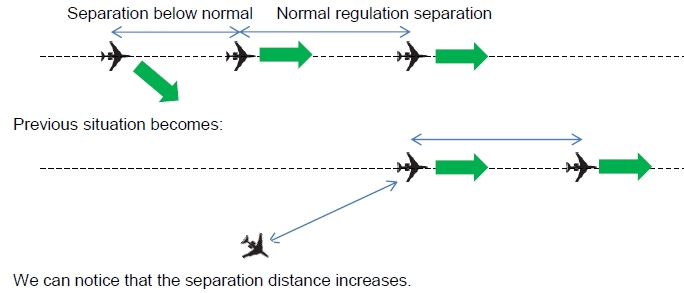
Air traffic controllers may divert aircraft from a previously assigned route for an arbitrary amount of time, which can provide any amount of horizontal separation depending on aircraft altitude and ground speed.
Remember that typical minimum radar separation distance is 5NM and minimum reduced separation distance is 3NM where applicable. Consult IFR radar separation documentation.
¶ Radar vectoring to reduce separation for optimal sequence
Sometimes the traffic situation separation is greater than the requested regulation separation.
In this case, the air traffic controller can give vectors to one or several aircraft in order to reduce the horizontal separation with previous aircraft in the approach sequence or to shorten the distance to the approach gate area.

The advantage of this method is that air traffic controllers will ensure the continuity of air traffic flow management and answer the need of fuel saving requested by airline companies.
If an aircraft is the first aircraft in the approach sequence, his route should be shortened toward the approach gate in order to create separation distance with succeeding traffic.
¶ Radar vectoring for traffic management and sequencing
As explained in the previous chapters, the main goal of approach management is to organize a sequence of aircraft providing a continuous flow towards the final approach path. Radar vectoring is one of the best methods to achieve efficient sequencing.
During approach, the distance between aircraft under radar vectoring depends on the runway capacity, the approach type (precision or non-precision) and category, the meteorological conditions (LVP) and the specific operational constraints of the airport.
Nevertheless, the controller must always respect the radar separation minima fixed by the regulations.
A typical 5NM separation target is one of the most used methods to manage the traffic flow on the final approach area. This creates a possible management rule which implies to create a 2 minutes spacing. sequence of aircraft.

A 2 minutes spacing approach sequence will create 5NM separation when using a typical approach speed of about 150kt.
Some advices to reduce the risk of separation loss:
- Always maintain 1000ft vertical separation between aircraft which present a risk of being closer than the minimum separation (in the short or the long term; this means that air traffic controllers should monitor all aircraft speed).
- The integration of an aircraft into the approach sequence shall be realized with maintaining aircraft 1000ft higher than the highest aircraft between its preceding and its following. The altitude shall be adjusted once the flight is correctly integrated and horizontally separated and regulated.

In the case of simultaneous descent of two close aircraft, the controller shall pay attention to their rate of descent in order to avoid separation loss.
Pay attention that aircraft in higher altitude also have higher true air speed.
In the training phase when air traffic controller is learning the approach regulation using radar, one method is to gradually increase the value of horizontal separation minimum of one nautical mile for each additional aircraft and maintain the vertical separation of 1000ft between each aircraft. This procedure should ensure 5 miles of horizontal separations overhead FAF/FAP between all aircraft.
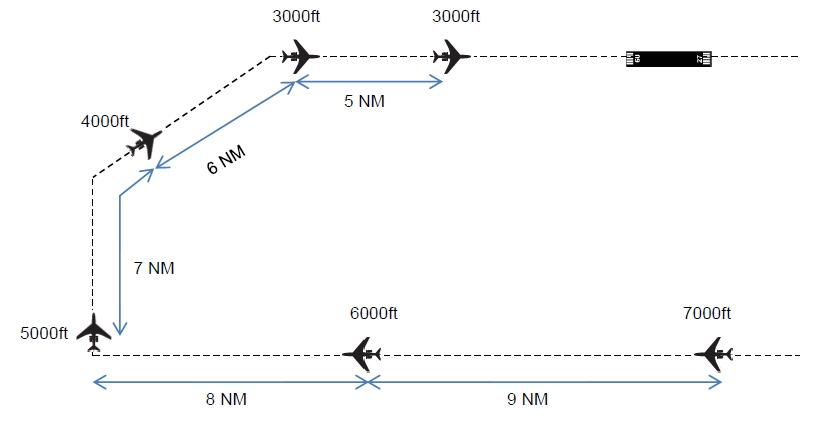
¶ Radar vectoring example
The diagram below shows some examples of radar vectoring tracks from different situations:
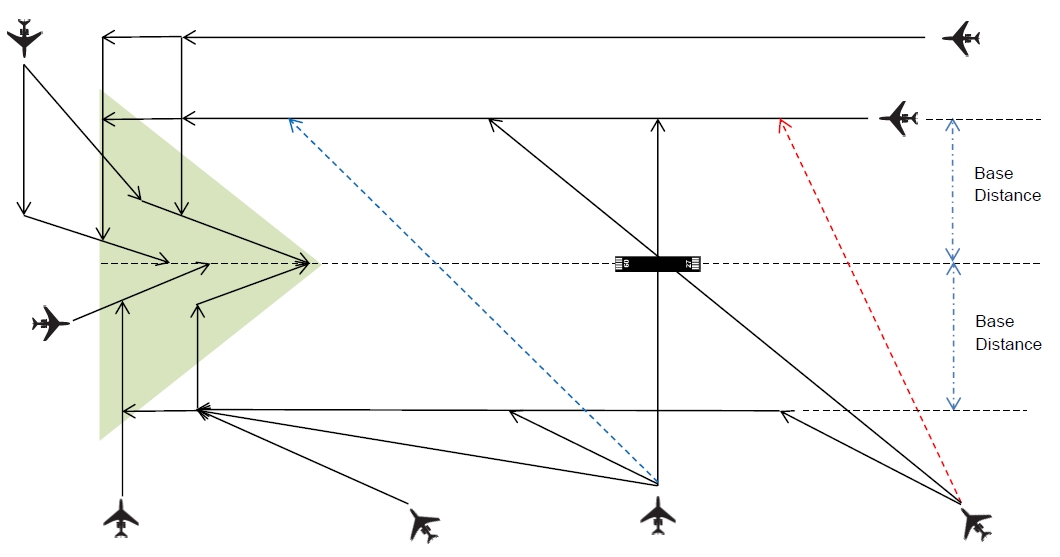
In the example presented above, we create downwind radar tracks in order to put all aircraft in the approach gate area (green zone) by using a 30° interception track to the final approach path.
The dotted arrows are possible tracks but not optimized and sometimes dangerous to use them in function of traffic:
- Blue dotted arrow track shows that the aircraft will overfly the final approach path. This track can be taken if the altitude is high enough to prevent any conflicts with final approach aircraft including the go-around aircraft.
- Red dotted arrow track shows that the aircraft will overfly the departure area where separation loss may occur with the departure aircraft and the go-around aircraft. This track can be used but the air traffic controller shall ensure the safety at all times.
Pay attention that the "Base Distance" is very important. When performing a quarter turn (90°) an aircraft will make an arc using a radius estimated at 0.5% (=Speed/200) of the ground speed in terms of Nautical Miles. It will be 1NM for 200kt
¶ Vectoring method on approach area for arrival aircraft
¶ Vectors and phraseology on final approach
To ensure a convenient interception of the final approach axis (LOC axis, VOR radial or NDB track) the approach controller generally shall use standard phraseology and provide:
- An interception heading (whenever the aircraft does not have a compatible heading already)
- An interception altitude (whenever the aircraft is not already established at final approach altitude)
- The final IFR approach clearance
- A speed restriction instruction if requested
**Example: **
- 📡KLM465, turn right heading 360, descent 2000ft, cleared ILS approach runway 03.
¶ Approach gate on final approach track
The approach gate is a radar point taken as a reference point by the air traffic controller for vectoring aircraft towards the final approach path. The approach gate shall not be less than one mile from the FAF/FAP (descending point on final approach), and shall not be less than five miles from the landing threshold.
¶ Rules
The approach gate is subject to following rules:
- The angle between aircraft heading and approach axis shall be higher than 10° and lower than 45° and the best angle should be ideally 30° with respect to the approach axis
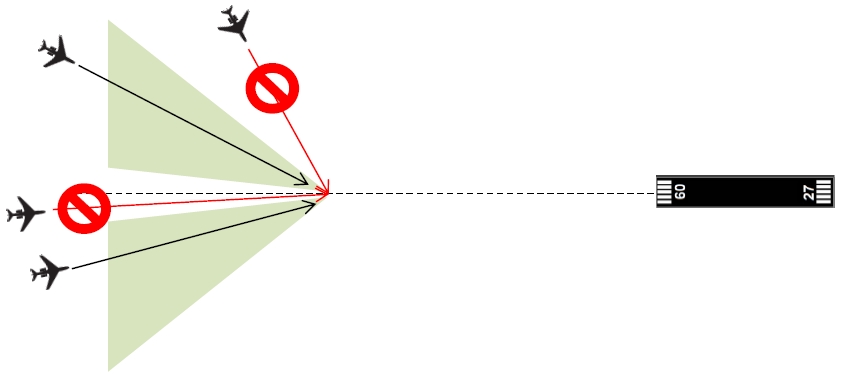
A higher angle than 45° shall only be possible with pilot approval before issuing the interception clearance. The maximum angle shall be 90°. Using a higher angle than 45° will induce overshoot.
A lower angle than 10° should be avoided due to the fact that the interception distance is not guaranteed due to cross wind effect and pilot reactivity.
- The interception of the final approach axis shall take place from a point which guarantees a straight leg of at least 30 seconds (1NM or 2NM distance) ahead the point of the starting of the descent FAF or FAP.

The interception can be possible up to the FAF/FAP only with pilot approval and where the situation demands it. This is not a normal radar vectoring operation.
- The interception of the descent slope is realized at level flight, once established on the final approach axis
- In case of an ILS approach, the interception of the glide slope shall be undercrossed at the published altitude (except when required or accepted by the pilot)
- Aircraft indicated airspeed shall be lower than 220kt IAS
The average interception speed of a Medium aircraft is usually between 180 and 200kt IAS.
¶ Use of approach gate
ATC should respect the defined approach gate at all times in order to ensure optimal final approach interception by aircraft.
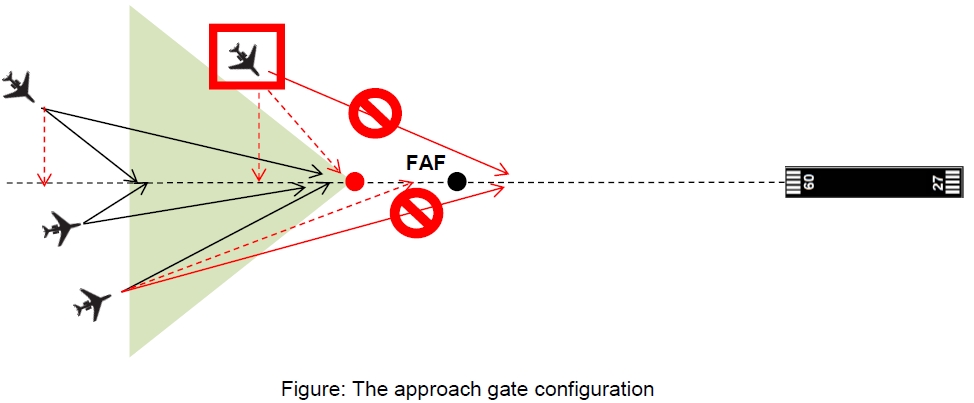
In the example above, the aircraft highlighted by the red square is outside of the approach gate. In normal operation and in this situation, the air traffic controller shall vector this aircraft into the approach gate area. If ATC force this aircraft to integrate on final, he can destroy the approach regulation or let the aircraft integrate the approach path with a risk to perform an non-stabilized final approach.
Summary:
Red point: Approach gate reference fix is defined by a straight leg of at least 30 seconds (1NM or 2NM distance) ahead the point where the aircraft start the descent (FAF or FAP point)
Black point: Final approach fix or point where the aircraft start the descent
Green zone: approach gate zone of good radar interception with a maximum of 45° angle
Black arrows: interception which respects the approach gate constraints
Red dotted arrows: interception which does not respect the approach gate constraints. These solutions should be used by ATC, only with pilot approval and where the situation demands it
Red arrows: bad interception. This situation forces the ATC to vector again the aircraft inside the approach gate zone
In other configurations, vectors can be provided to guide aircraft towards a different approach gate point:
- A fix or the interception path of the initial or intermediate approach procedure where radar vectoring cannot be provided on final approach procedure
- The Initial Approach Fix (IAF)
Vectors shall avoid mountainous areas.
Vectors shall be not used in areas where MRVA are higher than published procedures.
Note that the maximum range of the localizer in flight simulator is 26NM.
¶ Runway axis may be not aligned with the final approach track
In some medium or small airfields or airfields inside mountainous areas, the final approach track cannot be aligned with the runway axis.
The configuration may be one of these:
- Offset localizer followed by visual approach (especially in mountainous areas)
- Offset non precision approach
- Non precision approach followed by visual approach
In these configurations, the air traffic controller shall not guide aircraft towards the runway axis.
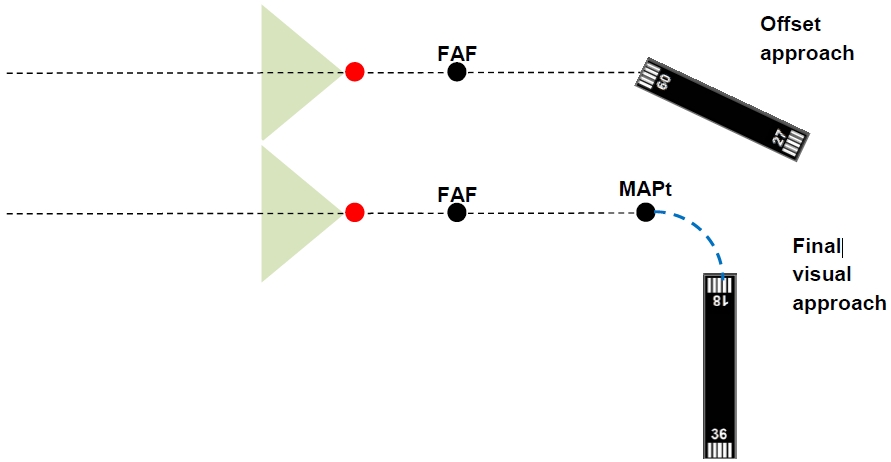
¶ Vectoring on final track with a base leg
In order to compensate the wind effect and pilot effectiveness for performing a base leg with two turns, the minimum base distance should be 3NM.
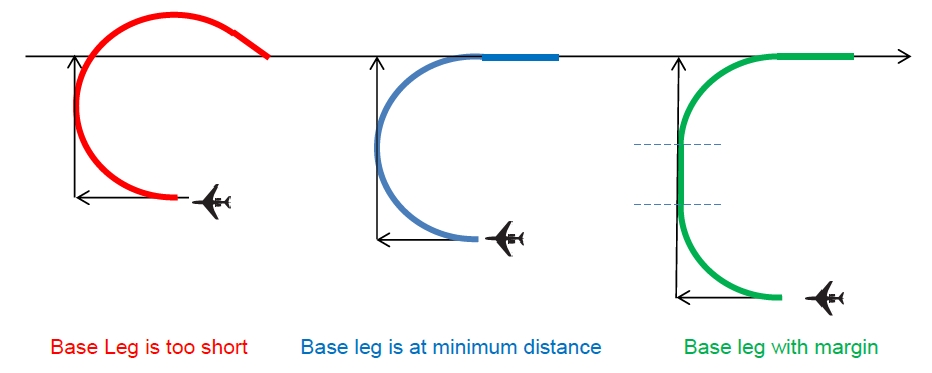
In order to ensure separation between aircraft on the final approach path and aircraft on the downwind track, the base leg created by radar vectoring shall be greater than the minimum IFR separation value considered in your approach area ( standard separation is 5NM and reduced separation is 3NM where applicable).
¶ Vectoring using a 45°/180° procedural turn
Sometimes aircraft will arrive in a bad configuration which does not allow for immediate interception of the final approach track. One simple method is to use a 45°/180° procedural turn form for vectoring toward the approach gate area.
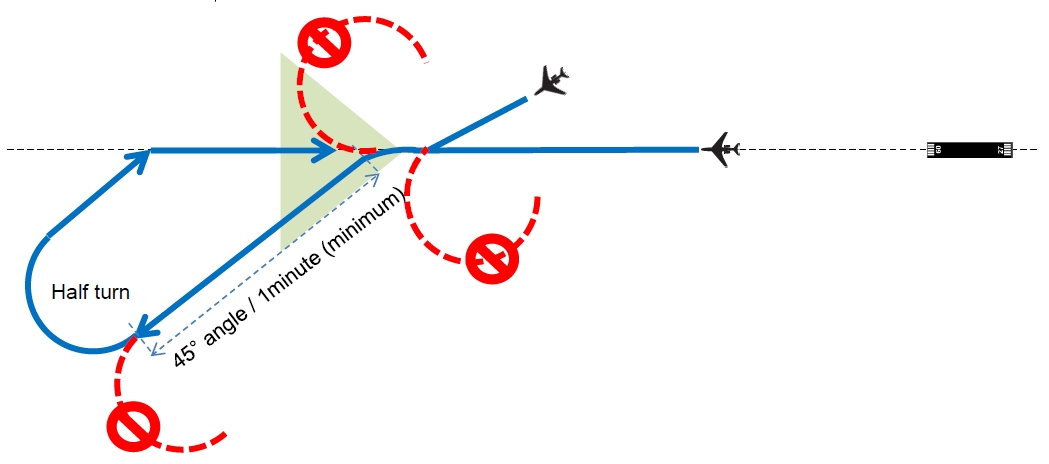
The procedural turn should be started beyond or at the approach gate reference point. The air traffic controller will:
- Give a new heading with a 45° turn (to the left or to the right) with respect to the approach axis
- Let aircraft maintain this heading for one minute minimum
- Give a half turn (180°) to the opposite direction of the runway (in order to make the aircraft compatible with the approach gate area).
- After half turn, give the final approach clearance
¶ Vectoring and emergency
If during radar vectoring one of the aircraft requests priority landing due to an emergency situation, the air traffic controller has to vector this aircraft through a route as short as possible to the final approach fix/point (FAF/FAP).
An aircraft in an emergency situation has absolute priority over all aircraft in the operation area.
The air traffic controller shall follow these basic recommendations:
- Aircraft which are in sequence behind the aircraft in the emergency situation will continue through an unchanged route,
- Aircraft which are in sequence in front of the aircraft in the emergency situation will continue to the end of the approach sequence.
This manoeuvre ensures minimum delay for all flights.

In the example above, the situation is:
- Approach sequence is constituted with 4 aircraft.
- The second aircraft in sequence is in emergency (red square)
The air traffic controller shall cancel the arrival of the first aircraft (orange square) and put it at the end of the approach sequence. The two other aircraft (green rectangle) shall continue and ATC shall monitor the emergency progress and the separation with other traffic.
- None
- ICAO Documentation 4444 - Air Traffic Management - 16th Edition 2016 - Chapter 8.6.5
- VID 150259 - Creation
- VID 200696 - Update
- VID 531824 - Wiki Integration
- VID 496402 - Wiki.js integration